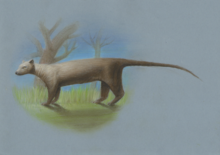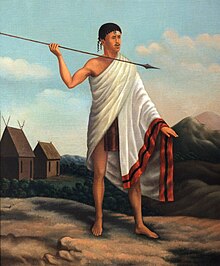
Back بوابة:مدغشقر Arabic Portal:Madagascar Spanish Portail:Madagascar French Portale:Madagascar Italian Portaal:Madagaskar Dutch Portal:Madagáscar Portuguese Портал:Мадагаскар Russian ද්වාරය:මැඩගස්කරය Singhalese باب:مڈغاسکر Urdu
The Madagascar Portal
Madagascar, officially the Republic of Madagascar, is an island country comprising the island of Madagascar and numerous smaller peripheral islands. Lying off the southeastern coast of Africa, it is the world's fourth largest island, the second-largest island country and the 46th largest country in the world. Its capital and largest city is Antananarivo. Following the prehistoric breakup of the supercontinent Gondwana, Madagascar split from Africa during the Early Jurassic, around 180 million years ago, and split from the Indian subcontinent around 90 million years ago, allowing native plants and animals to evolve in relative isolation; consequently, it is a biodiversity hotspot and one of the world's 17 megadiverse countries, with over 90% of wildlife being endemic. The island has a subtropical to tropical maritime climate. Madagascar was first settled during or before the mid-first millennium AD by Austronesian peoples, presumably arriving on outrigger canoes from present-day Indonesia. These were joined around the ninth century AD by Bantu migrants crossing the Mozambique Channel from East Africa. Other groups continued to settle on Madagascar over time, each one making lasting contributions to Malagasy cultural life. Consequently, there are 18 or more classified peoples of Madagascar, the most numerous being the Merina of the central highlands. Until the late 18th century, the island of Madagascar was ruled by a fragmented assortment of shifting sociopolitical alliances. Beginning in the early 19th century, most of it was united and ruled as the Kingdom of Madagascar by a series of Merina nobles. The monarchy was ended in 1897 by the annexation by France, from which Madagascar gained independence in 1960. The country has since undergone four major constitutional periods, termed republics, and has been governed as a constitutional democracy since 1992. Following a political crisis and military coup in 2009, Madagascar underwent a protracted transition towards its fourth and current republic, with constitutional governance being restored in January 2014. (Full article...) This is a Featured article, which represents some of the best content on English Wikipedia..
 Cryptoprocta spelea, also known as the giant fossa, is an extinct species of carnivore from Madagascar in the family Eupleridae which is most closely related to the mongooses and includes all Malagasy carnivorans. It was first described in 1902, and in 1935 was recognized as a separate species from its closest relative, the living fossa (Cryptoprocta ferox). C. spelea was larger than the fossa, but otherwise similar. The two have not always been accepted as distinct species. When and how C. spelea became extinct is unknown; there is some anecdotal evidence, including reports of very large fossas, that there is more than one surviving species. (Full article...)Selected article -
Women in Madagascar generally live longer than men, whom they outnumber. Marrying young, they are traditionally subservient to their husbands. Roughly a third have their first child before the age of 19, and those who wish to delay having children may not have access to contraceptives. Although it is illegal with no exceptions, abortion is common, with an estimated 24 percent of women having had one. While they are constitutionally equal to men, they have unequal property rights and employment opportunities in certain areas. (Full article...) This is a Good article, an article that meets a core set of high editorial standards.
Andrianampoinimerina (Malagasy pronunciation: [anˈɖʐianˌmpuʲnˈmerʲnə̥]) (c. 1745–1810) ruled the Kingdom of Imerina on Madagascar from 1787 until his death. His reign was marked by the reunification of Imerina following 77 years of civil war, and the subsequent expansion of his kingdom into neighboring territories, thereby initiating the unification of Madagascar under Merina rule. Andrianampoinimerina is a cultural hero and holds near mythic status among the Merina people, and is considered one of the greatest military and political leaders in the history of Madagascar. Andrianampoinimerina took power upon deposing his uncle, King Andrianjafy, who had ruled over Imerina Avaradrano (Northern Imerina). Prior to Andrianampoinimerina's reign, Imerina Avaradrano had been locked in conflict with the three other neighboring provinces of the former kingdom of Imerina that had last been unified under King Andriamasinavalona a century before. Andrianampoinimerina established his capital at the fortified town of Ambohimanga, a site of great spiritual, cultural and political significance that was designated a UNESCO World Heritage Site in 2001. The king's original royal lodgings can still be visited at Ambohimanga today. From this position, he progressively extended his domain first over all Imerina and then over the greater Highlands, absorbing the Betsileo, Sihanaka, Bezanozano and Bara territories. Having reigned for 23 years at the time of his death, Andrianampoinimerina had successfully reunited Imerina and vastly expanded the Merina kingdom, with the intent to ultimately unify all of Madagascar under Merina rule. His son and heir, Radama I, continued the conquests Andrianampoinimerina had begun, and over the next two decades largely achieved his father's vision. (Full article...)General images -The following are images from various Madagascar-related articles on Wikipedia.
Selected panoramaLandscape near Fianarantsoa, Madagascar.
TopicsCategoriesSelected pictureAssociated WikimediaThe following Wikimedia Foundation sister projects provide more on this subject:
Discover Wikipedia using portals | |||
© MMXXIII Rich X Search. We shall prevail. All rights reserved. Rich X Search












































































